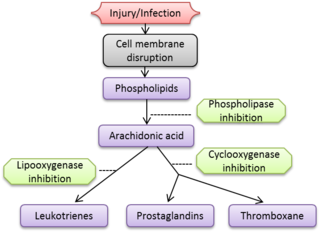 W
WAlexidine is an antimicrobial of the biguanide class. It is also a bisbiguanide.
 W
WAsphodelin A is an antimicrobial arylcoumarin made by Asphodelus microcarpus.
 W
WAtromentin is a natural chemical compound found in Agaricomycetes fungi in the orders Agaricales and Thelephorales. It can also be prepared by laboratory synthesis. Chemically, it is a polyphenol and a benzoquinone.
 W
WAustrocortilutein is an organic compound that also serves as an antibacterial metabolite found in the Dermocybe splendida mushroom.
 W
WAustrocortirubin is an antibacterial metabolite found in the Dermocybe splendida mushroom.
 W
WAzerizin is claimed to be a proprietary blend of the natural ingredients nicotinamide, azelaic acid, quercetin and curcumin that purportedly combine the anti-inflammatory and antimicrobial properties, along with inhibiting effects on sebum production.
 W
WBenzyl alcohol is an aromatic alcohol with the formula C6H5CH2OH. The benzyl group is often abbreviated "Bn" (not to be confused with "Bz" which is used for benzoyl), thus benzyl alcohol is denoted as BnOH. Benzyl alcohol is a colorless liquid with a mild pleasant aromatic odor. It is a useful solvent due to its polarity, low toxicity, and low vapor pressure. Benzyl alcohol has moderate solubility in water (4 g/100 mL) and is miscible in alcohols and diethyl ether. The anion produced by deprotonation of the alcohol group is known as benzylate or benzyloxide.
 W
WCarbadox is a veterinary drug that combats infection in swine, particularly swine dysentery.
 W
WChlorbisan is a toxic halogenated organosulfide. It is used as a microbicide.
 W
WCinoxacin is a quinolone antibiotic that has been discontinued in the U.K. as well the United States, both as a branded drug or a generic. The marketing authorization of cinoxacin has been suspended throughout the EU.
 W
WCopper usnate is the copper salt of usnic acid. It has been used as an antimicrobial.
 W
WDBNPA or 2,2-dibromo-3-nitrilopropionamide is a quick-kill biocide that easily hydrolyzes under both acidic and alkaline conditions. It is preferred for its instability in water as it quickly kills and then quickly degrades to form a number of products, depending on the conditions, including ammonia, bromide ions, dibromoacetonitrile, and dibromoacetic acid. DBNPA acts similar to the typical halogen biocides.
 W
WDehydrocurvularin is an antimicrobial made by Penicillium.
 W
WDichloroisocyanuric acid, also known as dichlor or dichloro-s-triazinetrione and is marketed under many names (e.g. troclosene), is a chemical compound with the formula (C(O)NCl)2(C(O)NH).
 W
WA formaldehyde releaser, formaldehyde donor or formaldehyde-releasing preservative is a chemical compound that slowly releases formaldehyde.
 W
WMalachite green is an organic compound that is used as a dyestuff and controversially as an antimicrobial in aquaculture. Malachite green is traditionally used as a dye for materials such as silk, leather, and paper. Despite its name the dye is not prepared from the mineral malachite, and the name just comes from the similarity of color.
 W
WThe micro-atmosphere method is an antimicrobial testing method involving the use of potentially bacteriostatic or fungicidal compounds which are obtained from the volatile oils of plants, such as citronella grass. This method involves the use of essential oils, a growth medium, a selection of bacterial or cultures and an incubator.
 W
WNiphimycin is an antimicrobial made by Streptomyces.
 W
WPolynoxylin is an antiseptic for local treatment of the skin and the mouth. It is a formaldehyde releasing antimicrobial polymer.
 W
WThe preorbital gland is a paired exocrine gland found in many species of hoofed animals, which is homologous to the lacrimal gland found in humans. These glands are trenchlike slits of dark blue to black, nearly bare skin extending from the medial canthus of each eye. They are lined by a combination of sebaceous and sudoriferous glands, and they produce secretions which contain pheromones and other semiochemical compounds. Ungulates frequently deposit these secretions on twigs and grass as a means of communication with other animals.
 W
WRitiometan is an antibacterial used in nasal sprays. Also, it is used in an aerosol preparation for the treatment of infections of the nose and throat. It is marketed in France under the trade name Nécyrane.
 W
WThe tirandamycins are a small group of natural products that contain a bicyclic ketal system and a tetramic acid moiety, the latter of which is found in different natural products from a variety of sources and which is characterized by a 2,4-pyrrolidinedione ring system. Members of this structural family have shown a wide range of biological activities like in antiparasitic, antifungal and anti-HIV evaluations, and furthermore, have shown potential usefulness because of their potent antibacterial properties. Streptolydigin, an analogue of the tirandamycins, is known to function as an antibacterial agent through inhibiting the chain initiation and elongation steps RNA polymerase transcription. The structural diversity in the tirandamycin family originates from the different oxidation patterns observed in the bicycic ketal system, and these modifications are determinant features for the bioactivity associated with these molecules.
 W
WTribromometacresol is an antifungal medication. This compound belongs to the class of organic compounds known as meta cresols, containing a meta cresol moiety which consists of a benzene ring bearing a methyl group and a hydroxyl group at ring positions 1 and 3, respectively.
 W
WTrichloroisocyanuric acid is an organic compound with the formula (C3Cl3N3O3). It is used as an industrial disinfectant, bleaching agent and a reagent in organic synthesis. This white crystalline powder, which has a strong "chlorine odour," is sometimes sold in tablet or granule form for domestic and industrial use. Salts of trichloroisocyanuric acid are known as trichloroisocyanurates.
 W
WTriclocarban is an antibacterial chemical once common in, but now phased out of, personal care products like soaps and lotions. It was originally developed for the medical field. Although the mode of action is unknown, TCC can be effective in fighting infections by targeting the growth of bacteria such as Staphylococcus aureus. Additional research seeks to understand its potential for causing antibacterial resistance and its effects on organismal and environmental health.
 W
WVerrulactones are alternariol-derived antimicrobial chemical compounds isolated from Penicillium.
 W
W W
W W
W W
W W
W W
W W
W W
W W
W W
W